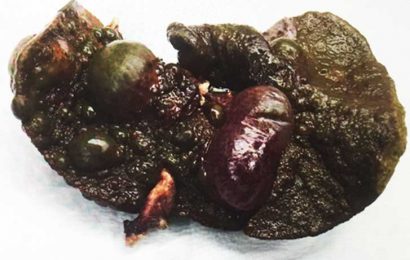A daily prednisolone dose of 5 mg or higher is associated with increased risk for major adverse cardiovascular events (MACE) among patients with rheumatoid arthritis (RA), data suggest. Patients taking daily doses below this threshold did not appear to have an increased risk of MACE, compared with those not taking glucocorticoids (GCs).

Dr Lai-Shan Tam
Previous studies have shown a dose-dependent increase in the risk of all-cause and cardiovascular (CV) mortality above a 7.5- to 8-mg dose of prednisolone, but “the question of whether there is a CV-safe dose and duration of GC use remains a topic of debate,” senior author Lai-Shan Tam, MD, a professor in the Department of Medicine and Therapeutics at the Chinese University of Hong Kong, told Medscape Medical News in an email.
Other studies of GCs and CV risk among RA patients have yielded conflicting results, especially for low-dose GCs. Findings from a 2020 study published in PLOS Medicine suggested that patients who had several immune-mediated inflammatory diseases ― including RA ― and who took less than a 5-mg prednisolone-equivalent dose daily had 74% higher risk for all-cause CVD, compared to nonusers. But results from a 2021 study published in Annals of the Rheumatic Diseases suggested that a daily prednisone dose of 4 mg or less did not increase cardiovascular events over a period of 6 months to 1 year.
These contradictory results were “primarily due to incomplete control of confounding variables, such as failure to adjust for C-reactive protein (CRP) levels,” Tam said. “Our study aimed to use a big data analytical approach to determine the effect of systemic GC dose and duration on the risk of major adverse cardiovascular events in patients with RA, while controlling for systemic inflammation, traditional CV risk factors, and other therapies.”
Is There a “Safe” Dose for Glucocorticoids?
To analyze this relationship, Lam and colleagues used the Hospital Authority Data Collaboration Laboratory, a citywide healthcare database. The investigators recruited patients with RA who had no history of MACE from 2006 to 2015 and followed them until the end of 2018. The primary outcome was the first occurrence of a MACE, defined as a composite of myocardial infarction (MI), unstable angina, ischemic or hemorrhagic cerebrovascular accident, transient ischemic attack, and CV death.
The study was published in Annals of the Rheumatic Diseases on July 24, 2023.
The analysis included 12,233 patients with RA and had over 105,826 person-years of follow-up. The average follow-up time was 8.7 years. During the study period, 860 patients had their first MACE. After controlling for confounding factors, a daily prednisolone dose of 5 mg or higher doubled the risk for MACE, compared with GC nonusers. MACE risk increased by 7% per month.

Dr Christie Bartels
This quantification of the risk for MACE according to GC dosing ― particularly the increase in risk over time ― “is incredibly helpful for counseling patients, because I think most patients would not opt for that risk category,” Christie Bartels, MD, who heads the Division of Rheumatology at the University of Wisconsin School of Medicine and Public Health, in Madison, Wisconsin, told Medscape. She was not involved with the study.
Long-Term Glucocorticoid Use Discouraged
Daily doses of less than 5 mg were not associated with higher MACE risk, but more research is necessary to understand whether these low doses are clinically efficacious, Tam said. “The study results suggest that a very-low-dose GC (less than 5 mg prednisolone daily) may be cardiovascular risk neutral. However, further evaluation is needed to determine whether this dose is therapeutic. Other potential side effects, such as bone loss, increased infection risk, dyslipidemia, and hyperglycemia, should also be considered.”
Both the American College of Rheumatology and the European Alliance of Associations for Rheumatology acknowledge that short-term GCs may be necessary for some RA patients, but they emphasize using the smallest necessary dose for the shortest period possible because of the known toxicity of GCs.
“We recommend stopping GCs as soon as it is clinically feasible, in line with previous recommendations, until these issues are investigated further,” Tam added.
Bartels agreed that long-term use of GCs should be avoided if possible, even at lower doses, because although CV risk may be less of an issue, studies have shown an increased risk for infection even at GC doses of less than 5 mg a day.
How Might Risk Increase With Dose?
While the study showed a distinct difference in risk with doses of prednisolone higher and lower than 5 mg, more information on how risk increases with dose could be useful, said Beth Wallace, MD, an assistant professor in internal medicine at the University of Michigan and a staff rheumatologist at the VA Ann Arbor Healthcare Center. She was also unaffiliated with the research. “If someone is on 5–10 mg…how much better is that than being on 10–20 mg or being on 20–30 mg?” she asked. While these study findings are “very important,” she said, it would be useful to know the risk associated with 7.5 mg vs a higher dose.

Dr Beth Wallace
Wallace also noted that the study population was generally healthy, with lower rates of diabetes, high blood pressure, and high cholesterol, compared with American patients. The mean disease duration at baseline was around 8 months, and only 3% were taking biologics. Performing this type of analysis in a US or global cohort would be useful to see whether risk estimates are similar, Bartels said.
But even in this relatively healthy population in Hong Kong, “taking more than 5 mg of prednisolone doubles the risk of cardiovascular disease,” Wallace added. This is important for clinicians to know, especially if they are more cautious about prescribing steroids to older or sicker patients but are “using [the drugs] a little more indiscriminately in younger people and healthier people.”
The study did not receive outside funding. Tam and Bartels report no relevant financial relationships. Wallace has received a grant from the Department of Veterans Affairs Administration to study steroid tapering in RA.
Ann Rheum Dis. Published online July 24, 2023. Abstract
For more news, follow Medscape on Facebook, Twitter, Instagram, and YouTube.
Source: Read Full Article


